These free crochet stitches will help you grow your library of stitches quickly. When you learn how to crochet and you have mastered the basic stitches, you might want to move on to more advanced stitches. Advanced crochet stitches are not as difficult as it seems or you might think. They are usually just a combination of basic crochet stitches and is great for meditative crochet.
You might feel overwhelmed by all the techniques and variations that are available. Not to worry, if you have been wondering how to do a specific stitch, you have come to the right place to learn and find crochet patterns for free.
Crochet is a fun and meditative craft. These are some of the most popular advanced stitches that use basic stitches.
Advanced Crochet Stitches
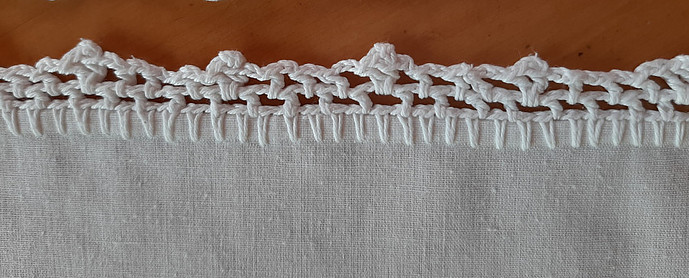
Advanced crochet stitches normally build on the basic crochet stitches. This could be that multiple stitches are worked into the same stitch, or multiple stitches could be worked across several stitches to create a special stitch.
Some stitches, like Star stitch and Catherine’s Wheel, use a combination of basic stitches. Follow these simple steps to learn how to crochet some of the most popular stitches. You can visit Knitpicks to purchase your hooks and yarns for your projects.
Find a huge selection of beautiful yarns here at very affordable and competitive prices, together with kits and gift ideas for crafters.
Look out for the abbreviations that are used in this post at the bottom of the page, together with crochet patterns for free.
Moss stitch
Moss stitch is also known as Garter stitch. It is an easy stitch to learn and it uses single crochet and chain stitch as the two basic stitches. To crochet a sample piece, make a chain with an odd (uneven) amount of stitches. 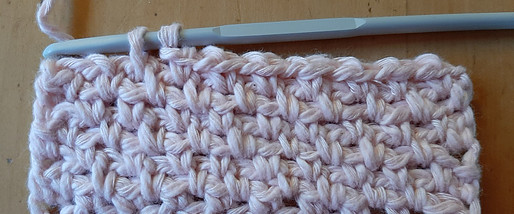
- Row 1: Put a marker in the first ch from the hook, sc in the 3rd chain from the hook. * ch 1, skip next ch, sc in next ch. Repeat from * across the row, ch 1 and turn.
- Row 2: * sc in the next ch-1sp, ch 1. Repeat across the row. At the end of the row, make a sc in the stitch where the marker is (first remove the marker), ch 1 and turn.
- Row 3: Work across the row the same as in row 2 till the end of the row. Work the last sc in the turning chain of the previous row, ch 1 and turn.
- All subsequent rows are worked as row 3, until you have reached the required length. No turning ch is required in final row, break yarn and work away the ends.
The marker is an easy way to see which stitch to work into. But once you get the hang of doing moss stitch, you won’t need the marker. To crochet a baby blanket in moss stitch, is an easy pattern for beginners or any skill level and is a great stitch for meditative crochet.
Single Crochet Mesh Stitch
This is similar to moss stitch and only uses the basic stitches of single crochet (sc)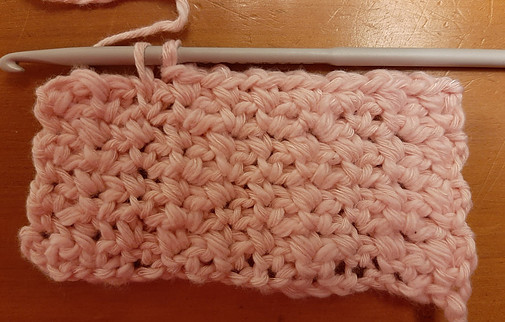 and chain stitch (ch), but a different look is achieved. To start, make a chain with an odd number of stitches.
and chain stitch (ch), but a different look is achieved. To start, make a chain with an odd number of stitches.
- Row 1: sc in the 3rd chain from the hook, * ch 1, skip next ch, sc in next ch. Repeat across the row, ch 1 and turn.
- Row 2: sc in first sc, skip next ch * sc in next sc, ch 1, skip next ch. Repeat across the row and end with sc in the last sc. ch 1 and turn.
- Repeat row 2 until you have the desired size. On the final row, don’t do the turning chain. Break off yarn and work away ends.
Tip for beginners: instead of making the last sc in the last sc, crochet the last sc into the turning ch. This might help you to achieve straighter edges.
Whichever way you opt for, just be consistent in what you do. Use either of these free crochet stitches to create interesting items.
V stitch
This is another very easy stitch that uses two basic stitches, double crochet and chain stitch. The basis that makes up a V stitch is a dc, followed by a ch, and another dc, all in the same space of the stitch. 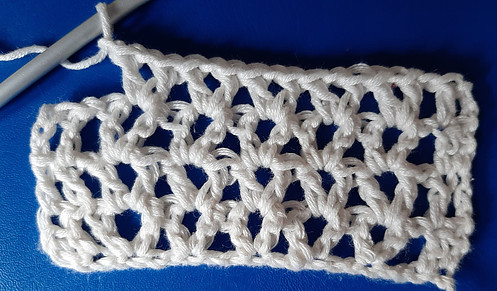 There are many variations and possibilities that you can construct with this.
There are many variations and possibilities that you can construct with this.
Start with a chain that is a multiple of 3 plus 7.
To complete each V stitch, work 1 dc, 1 ch, 1 dc in the same stitch or space. To make a sample piece, make a chain with 22 stitches ((3 x 5) + 7).
- Row 1: dc in the 4th ch from the hook (this will count as the first dc in the row). ch 1, skip next ch, * dc in next ch, ch 1, dc in same ch, skip 2 chains. Repeat the sequence from * across the row. At the end of the row (when there are 4 ch left), ch 1, skip 2ch, then work 1 dc in each of the next 2 chain stitches. ch 3 and turn. In this sample piece there are 5 V stitches and the ends.
- Row 2: the turning chain makes up the first dc in the row. Dc in the next dc, ch 1, work 1 V stitch in each V stitch across the row. Ch 1, skip next ch, work 1 dc in each of the last 2 dc sets.
- Repeat row 2 until you have the desired size. Secure the last stitch and work away the ends.
V Stitch in Brick Repeat
There are many variations of the basic V stitch. In the Brick Repeat the construction is basically the same,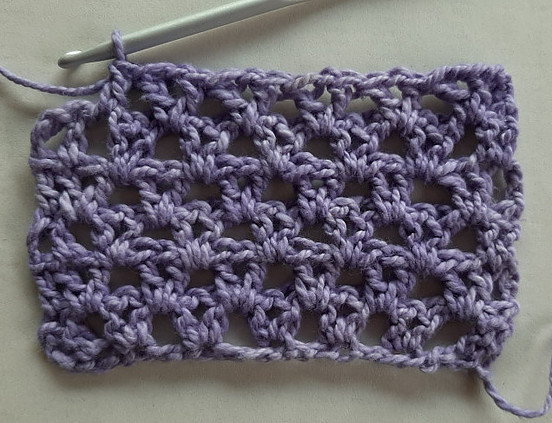 but V stitches are repeated in a pattern that resembles brickwork, with V sts made in the space between the V sts in the previous row.
but V stitches are repeated in a pattern that resembles brickwork, with V sts made in the space between the V sts in the previous row.
To make a practice piece, make a chain with a multiple of 3 plus 7. I used 22 stitches ((3 x 5) +7)
- Row 1: dc in the 4th ch from the hook (this will count as the first dc in the row). ch 1, skip next ch, * dc in next ch, ch 1, dc in same ch, skip 2 chains. Repeat the sequence from * across the row. At the end of the row (when there are 4 ch left), ch 1, skip 2ch, then work 1 dc in each of the next 2 chain stitches. ch 3 and turn.
- Row 2: the turning ch forms the first dc in the row. * dc in the space between 2 V sts, ch 1, dc in the same space. Repeat from * across the row, dc in the turning chain, ch 3 and turn.
- Row 3: dc in next dc, ch 1, continue with making V sts in the space between the V’s to the end of the row, ch 1, dc in the last dc, dc in the turning chain, ch 3 and turn.
- Continue to repeat row 2 and row 3 till the desired length. Finish without doing the final ch3. Break yarn and work away the ends.
Picot Edging
Picot is a simple edge that only uses chain stitch and single crochet to form a pretty round bump along the edge.
There are many variations and the basic picot is that from the point in the crochet that you want to have a picot, ch 3, insert the hook in the 3rd ch from the hook. Yarn over and pull the yarn through the stitch and the loop. It can be worked over any number of stitches, depending on how far apart you want the picots or bumps to be. 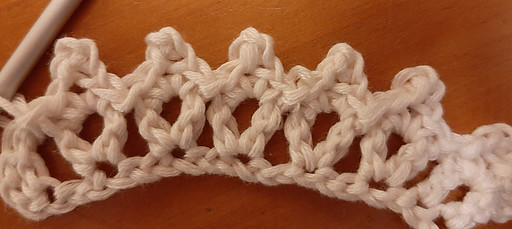 Variation no. 1: To make a Picot edging on V stitch: The basis is that you sl st in the space between 2 v sts * sc in next V st, ch 3, sl st in 3rd chain from the hook, sc in same V st, sl st in space between 2 V sts. Repeat from * across the row and finish with sc. Break off yarn and work away the ends.
Variation no. 1: To make a Picot edging on V stitch: The basis is that you sl st in the space between 2 v sts * sc in next V st, ch 3, sl st in 3rd chain from the hook, sc in same V st, sl st in space between 2 V sts. Repeat from * across the row and finish with sc. Break off yarn and work away the ends.
Variation no. 2: Make a picot edge after an additional row, so do the V st row or round first and followed by 2 rows. 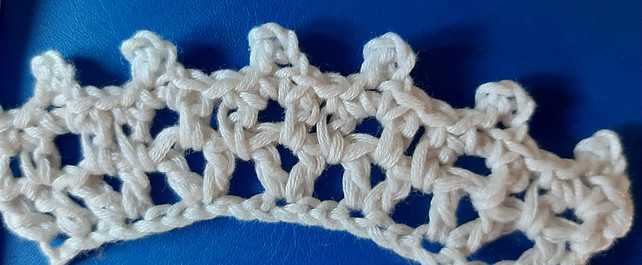
- Next row: sc in space between the dc and V st of the previous row, * ch 3, sc in ch-1sp, ch 3, sc in space between 2 v sts, repeat from * across and at the end sc in turning chain, ch and turn.
- Next row: * sc in ch-1sp, ch4, sl st in 4th chain from hook, sc in same space, sl st in ch-1sp, repeat from * and finish with a sc. Break the yarn and finish the ends.
Use these crochet patterns for free to add trimmings with an edge of crochet. For example, napkins with a crocheted edge, or to make special gifts like a wedding present or birthday gifts.
Shell stitch
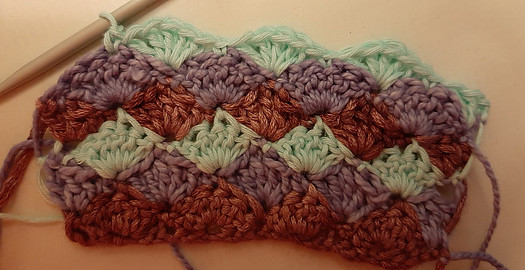
Shell stitch is a variety of different crochet stitches, rather than a specific stitch. Normally several basic crochet stitches, like double crochet or treble crochet, are worked together in a single stitch or space. This forms a shell shape.
So the shell shape of the stitch is narrow at the bottom where the stitches are worked together, and then fans out at the top.
Unlimited different effects and textures can be created by combining these free crochet stitches. Shell stitch is often worked in different colors to show up each shell and is another easy meditative crochet stitch.
To crochet a practice piece, make a chain with multiples of 6, plus 1 (so 26 ch or 31 ch etc.)
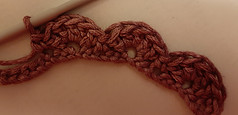
- Row 1: sc into the second chain from the hook, * skip the next 2 ch, dc into the next ch, and another 4 dc into the same ch (so that you have a total of 5 dc in the same stitch), skip next 2 ch, sc into the next ch. Repeat from * to the end of the chain and sc in the final ch. Make a turning chain of 3 stitches, which becomes the first dc of the new row. Turn.
- If you are using different colors, then make the turning chain in the new color.
- Row 2:
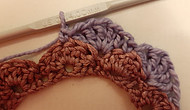 start with a half shell. 2dc in the first stitch. * skip next 2 stitches, sc in next dc (so the center stitch of the 5 stitch shell), skip next 2 stitches, 5dc in next sc. Repeat from * to the end of the row. 3dc in last sc to form another half shell. ch 1 and turn.
start with a half shell. 2dc in the first stitch. * skip next 2 stitches, sc in next dc (so the center stitch of the 5 stitch shell), skip next 2 stitches, 5dc in next sc. Repeat from * to the end of the row. 3dc in last sc to form another half shell. ch 1 and turn.
- Change colors for the turning chain if you are using multiple colors.
- Row 3: sc in first dc, * skip next 2 dc, 5dc in sc, skip next 2 dc, sc in next dc (which is middle of the shell). Repeat from * to the end of the row, skip next 2 dc and sc in turning chain, chain 3 and turn.
- Once again do the turning chain in a new color if you are using multiple colors.
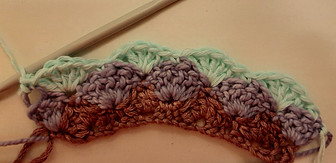
- Once again do the turning chain in a new color if you are using multiple colors.
- Repeat row 2 and row 3 until it has the desired length. Remember to change colors on the turning chain.
- On the final row, do not make the turning chain. Break off yarn and work away the ends.
Tip for beginners: when joining colors, crochet over the ends to secure them.
A single row of shell stitch makes a great edging for napkins or bed linen, or combine it with a picot edging to personalize gifts.
Seed Stitch
Seed stitch is another simple stitch that uses basic stitches of single crochet and double crochet and is suitable for beginners to try. Rows are worked alternating the two stitches in each row. The result is a dense fabric which is great for items where warmth is important, like blankets and accessories. Seed stitch is not too lacy or open. 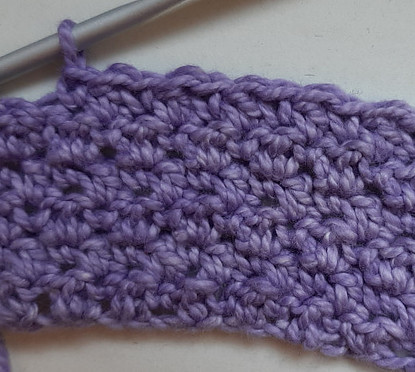
For meditative crochet you want a repetitive stitch, and seed stitch is great for that.
To make a sample piece, make a chain with an odd number of stitches.
- Row 1: sc in the fourth chain from the hook, * dc in the next ch, sc in the next ch. Repeat from * across the row and end with sc in the last ch. Ch 3 and turn.
- Row 2: Work each row with dc in the sc below and visa versa. Ch 3 and turn.
- The ch 3 and the end of each row forms the first dc in each row.
- Continue until you have reached the desired length and finish with sc. Break yarn and work away the ends.
Seed stitch is a great stitch to use for potholders, blankets, scarves and other accessories.
If you need yarn for your project, Amazon has a big selection. Or Knitpicks will help you with all your requirements.
We Crochet has a huge selection at very affordable and competitive prices, as well as gift ideas for crafters, kits and yarns and textiles.
Abbreviations
These are the abbreviations that you will come across in these directions for free crochet stitches.
- ch = chain
- ch-1sp = chain – 1 space, which is the space that is created when there is a chain stitch in the previous row.
- dc = double crochet
- hdc= half double crochet
- sc = single crochet
- sl st = slip stitch
- st = stitch
- sts = stitches
- tr = treble crochet
- yo = yarn over
Textured Crochet Stitches are advanced stitches that add dimension and thickness to your projects.
I hope you will expand your skill with these free crochet stitches, but if you have any questions or suggestions about advanced crochet stitches, please leave them below and I will get back to you.

Crochet was one of our lessons in primary school which I extremely enjoyed. It eventually became a hobby for me until middle school. Over the years, I completely set that hobby aside and forgot about it. Your article made me again interested to learn new tricks. I will start on learning shell stitch which I think will be a good accent for our coffee table. Thank you for your sharing!
Crochet is a great mindful craft and it can be picked up again after a long time, so I am pleased to hear that this has inspired you to pick up crochet again. Please let me know if you need help.
I have been wanting to renew my love for crocheting, and your post could be a sign to do so. I only know the basics, and I am not familiar with the advanced techniques, and I was actually looking for youtube videos to help me out with that. But thank you so much for your tips, I am actually looking at the helpful photos so I know where to begin with. I used to begin Catherine’s Wheel to make a small bag, but I gave up and made a beverage coaster instead. Haha! But I guess this could be a good time to retry. Thanks for the sign, you’ve got a nice blog. Cheers, A
Making a coaster instead of a bag is a great way of starting, so yes, it is a great time to try again. Let me know if you need help.
Well my goodness. I never thought there were so many stitches when it came to crochet. My wife has crocheted for years and I just showed her this and even she had no clue. Oh well she does now.
We both fell in love with the shell stitch so she is going to try something with that. The picot edging looks like it belongs on a crown so Im sure that will be the one after the shell
The internet is a great thing. Look at me. I have never crocheted but still ended up on your sit which in turn ended up with my wife learning something new
Thank you
Hi Dale, I am very pleased to hear that your wife can benefit from my post and the shell stitch is a lovely stitch and easy to master. Liné
I agree with you that crocheting is fun. It can be very rewarding and satisfying to see one’s handicraft producing a masterpiece that is helping to meet some needs. It is amazing how a combination of basic crochet stitches produce beautiful advance stitches. Thank you for sharing the different designs and the step by step to achieving them. To make a two-colour shawl, can I combine two balls of wool of the desired colours and follow the seed stitch design?
Hi Debbie, you can certainly combine two colours for your crochet project and I am sure it will look lovely in the seed stitch. Enjoy doing your project. Liné
It is amazing! My mother loves to do crochet stitches because my grandma taught her when she was a child. Currently, my mom is teaching my sister how to do this. I am sure she will glad to read this article because she tells my sister that if she wants perfect crochet, it will need that she improve her skills. I think this info will help them grow their library of stitches quickly.
My mother always wanted to do a beautiful shell stitch, now with this article, she will do it. Thanks for sharing.
Hi Andres, crochet is a great craft and actually easy to learn, so to have your mom that can teach your sister, is the best way. I am sure they both enjoy the craft. All the best, Liné
Your crochet stiches is quite unique, I have seen and made crochet before now,but yours is amazing . If you can codify the process of the advance crochet in a book or even making a video for it ,will be very useful for beginners even to those that are into crocheting that wish to be advanced in it.
Hi there, I am working on putting a course together, which takes a long time. But it is a very good suggestion to put together an eBook in the meantime that I could either offer for free or sell at a low price. Thank you for the suggestion.
I’ve always thought of crocheting to be a complicated endeavor but it really doesn’t seem to be the case when one get a few basics down. In fact, with repetition of these techniques, your skills will rise and you’ll find yourself crocheting in a more fluid manner than before. This is the ultimate win-win situation.
The toughest part would be learning the basics, but taking them one at a time, or even taking just one technique one week at a time, you’ll surprise yourself in learning such techniques after just a month to a month and a half. Definitely more than worth going through.
Hi Todd, you are quite right that it is learning a stitch at a time and starting with the basics. The more advanced crochet stitches just build on the basic stitches or are variations of the basic ones.
I love crotchet stitching and I do it as part of my hobby. Going through this article I get to learn new stitches and how to go about them which I didn’t know before. The shell stitch seems interesting to learn and a bit challenging but I love to challenge myself and learn new things. Thanks so much for sharing this article with us.
Hi there, the shell stitch is actually a very easy stitch to learn and as it is repetitive, it is also good for meditative crochet. I think using several different colours might seem to look more difficult, but try it in one color and I’m sure you will love it.